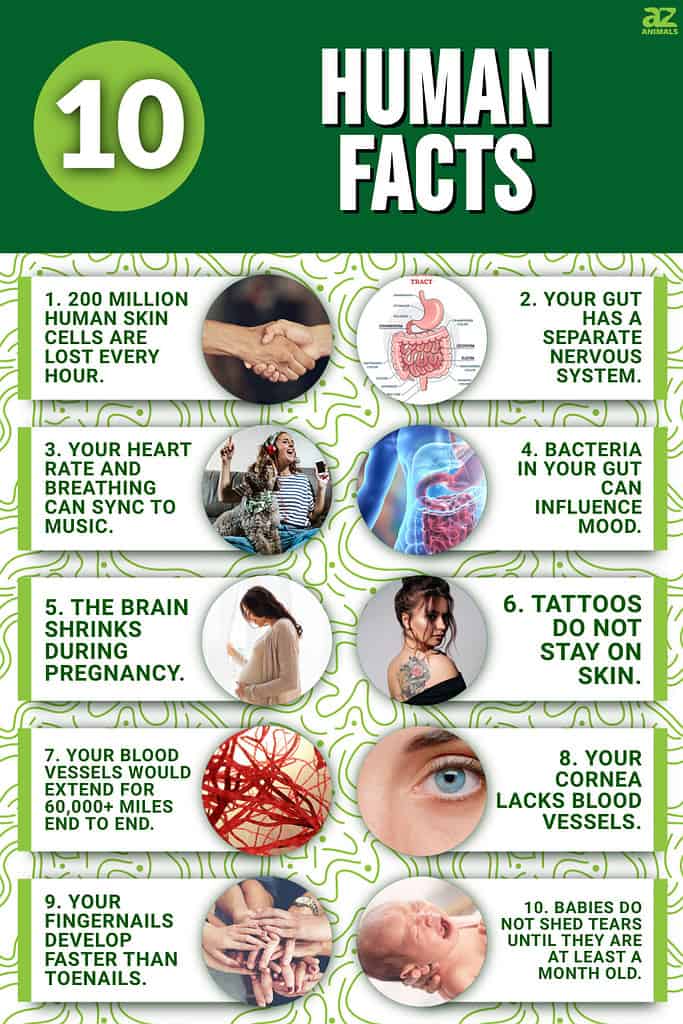The human body is incredible. It is a unique system of interrelated structures and essential organs that work continuously to perform the duties required for daily life. For instance, your mouth, esophagus, stomach, and small intestines combine to digest your food and give you the nutrients needed to keep you in good health.
While most of us know the essential physical functions that keep us alive, you may be unaware of some of your body’s amazing capabilities. This article comprises a list of 10 intriguing facts about the human body.

1. 200 Million Human Skin Cells Are Lost Every Hour
Your skin develops rapidly. About 200 million skin cells are shed every hour. Your epidermis (top skin layer) constantly replaces the dead cells. 90% of these layers contribute to the formation of new skin cells, while the other 10% create melanin, the pigment that gives skin its color.

The top layer of skin called the epidermis constantly replaces dead skin cells.
©PeopleImages/iStock via Getty Images
2. Your Gut Has a Separate Nervous System
All the organs that collectively comprise the gastrointestinal system (gut) — liver, pancreas, stomach, small intestine, colon, gallbladder, and rectum — are usually called the second brain. It’s the only organ in the body with its own neural system, which comprises 100 million neurons buried in the gut wall. Consider neurons to be your nervous system’s transmitters. They send signals to muscles, nerve cells, and gland cells all over your body.
This second brain is so strong that it can keep working even if the main neural link between your gut and your brain is cut. This means that, even if your brain couldn’t connect with your gut, neurons in your gut wall can still transfer the information needed for your digestive system to function independently.

The gastrointestinal system is the only organ in the body with its own neural system.
©iStock.com/VectorMine
3. Your Heart Rate and Breathing Can Sync to the Music You’re Listening to
The songs you listen to affect your blood pressure, pulse rate, and respiration. According to studies, changes in the respiratory and circulatory systems caused by listening to music immediately reflect the rhythm and intensity of the song.
For example, songs’ crescendos (rises in intensity and volume) can cause corresponding rises in blood pressure, heart rate, and breathing. Decrescendos and silent periods, on the other hand, cause a drop in these vitals. Repeated rhythms can also drive your system into sync with the beat. These results could lead to new treatments for strokes and other diseases.

Songs’ crescendos can cause rises in blood pressure, heart rate, and breathing.
©Lucia Romero/Shutterstock.com
4. Bacteria in Your Gut Can Influence Your Mood
The collection of bacteria in your stomach is known as your microbiome. This bacterial colony can affect neurological development, behavioral patterns, sensory abilities, and stress levels.
At birth, your gut is clean. Your GI tract will then produce several bacterial species over time, which can be affected by your genes and environmental germs.
The microbiome produces hundreds of neurochemicals, which your brain uses to govern memory, learning, and temperament. Your microbiome creates nearly all the serotonin in your body, a key hormone that regulates your mood, emotions, and happiness. Serotonin helps treat depression, anxiety, and poor bone health. It also helps people sleep, eat, and burn calories.

Your microbiome can affect neurological development, behavioral patterns, and stress levels.
©iStock.com/Rasi Bhadramani
5. Your Brain Shrinks During Pregnancy
Pregnant women have lower cortical thickness and surface area in grey matter areas of the brain, according to a 2017 research published in Nature Neuroscience journal. This finding gives the phrase “pregnancy brain” a whole new meaning. The cerebral cortex suffers the most from grey matter loss, particularly areas that regulate thinking skills and where we interpret emotions and nonverbal messages. But rather than being harmful, this volume reduction helps the brain understand social circumstances more quickly, especially when figuring out what babies want and how they feel.

During pregnancy, the cerebral cortex suffers the most from grey matter loss.
©Ground Picture/Shutterstock.com
6. Tattoos Do Not Stay on the Human Skin
Given that we shed our skin cells constantly, why do tattoos not wipe off? Well, the answer is that the ink does not stay in the skin but goes into your immune system. A type of white blood cell known as macrophages tries to heal the injury around the tattoo and eliminate the outsider. However, they cannot remove the ink, so they “eat” it and remain positioned to guard the skin.
When these cells die, others take their place and do the same thing; erasing tattoos is not easy.

The ink from a tattoo does not stay in the skin but goes into your immune system.
©AMSStudioAMS/ via Getty Images
7. Your Blood Vessels Would Extend for More Than 60,000 Miles From End to End
The circulatory system, made up of arteries, veins, and capillaries, is responsible for blood pumping. These vessels make sure blood is available in every part of your body. Oxygenated blood is carried to the heart by veins and away from the heart by arteries, while capillaries connect both of them.
The huge network of blood vessels would stretch for approximately 60,000 miles for a child and about 100,000 miles for an average adult human. Your capillaries, the tiniest blood vessels in your body, would account for roughly 80% of this length.

An average adult human’s network of blood vessels would stretch for 100,000 miles.
©iStock.com/Design Cells
8. Your Cornea Lacks Blood Vessels
The cornea is the transparent part of your eye that protects the pupil, iris, and anterior chamber. The cornea’s transparency lets light flow through to the retina and then to the brain, where it is processed. The reason for this transparency is that, alongside the cartilage, the cornea is the other tissue in the human body that lacks blood vessels.

The corneas let light flow through to the retina and the brain, where it is processed.
©sashamol/Shutterstock.com
9. Fingernails Develop Faster Than Toenails
Fingernails grow faster because they are exposed to sunlight more frequently. Also, the nails on your more active hand grow more quickly than those on the other hand. The longest nail is usually found in the middle finger. Generally, the size of the nail and the size of the finger are in direct proportion.

Did you know the nails on your more active hand grow more quickly than those on the other hand?
©Freebird7977/Shutterstock.com
10. Babies Do Not Shed Tears Until They Are at Least a Month Old
Professionals have affirmed that it is possible and perfectly normal for babies not to cry or do so without tears for up to the first three months. This is because their tear ducts are still developing at this time. Certain babies have blocked tear ducts, which means they can cry, but their tears don’t flow properly.
However, a sticky yellow discharge caused by collected tears can be managed with drops or ointment prescribed by your doctor. They will also demonstrate how to wipe your child’s eyes and, if necessary, soothe the tear duct.

Babies’ tear ducts are still developing for the first three months.
©iStock.com/Rachaphak
The photo featured at the top of this post is © iStock.com/DisobeyArt
Thank you for reading! Have some feedback for us? Contact the AZ Animals editorial team.






